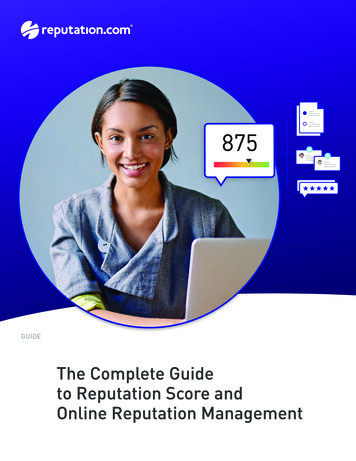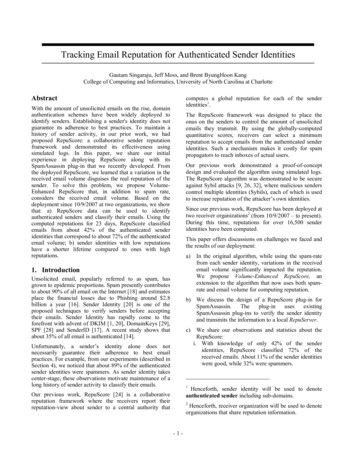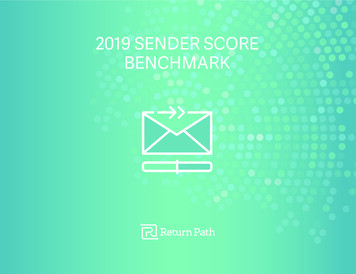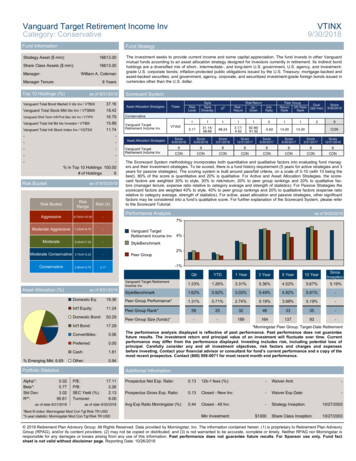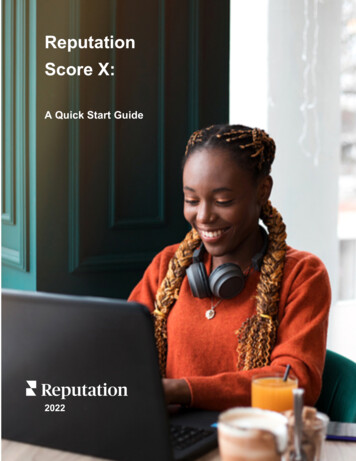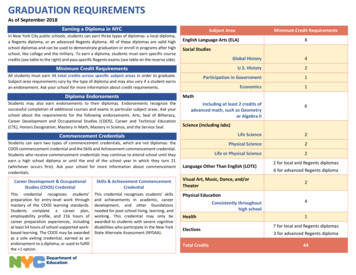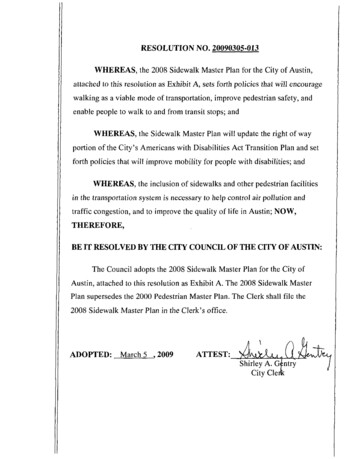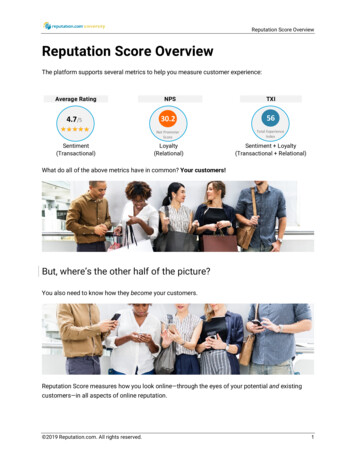
Transcription
Reputation Score OverviewReputation Score OverviewThe platform supports several metrics to help you measure customer experience:Average Rating4.7/5Sentiment(Transactional)NPSTXI30.256Net PromoterScoreTotal ExperienceIndexLoyalty(Relational)Sentiment Loyalty(Transactional Relational)What do all of the above metrics have in common? Your customers!But, where’s the other half of the picture?You also need to know how they become your customers.Reputation Score measures how you look online—through the eyes of your potential and existingcustomers—in all aspects of online reputation. 2019 Reputation.com. All rights reserved.1
Reputation Score OverviewHow Does Reputation Score Work?The Reputation Score is calculated on a 100 – 1,000-point scale. At a glance, you can determine thelevel of success of your locations’ online visibility, customer engagement, and sentiment. The higheryour Reputation Score is, the greater the likelihood you stand out among search engine, map results,and on review sites—and are doing the right things to be seen and chosen by new consumers.Score InfluencersThe Reputation Score is based on 30-day averages of the following key dimensions. Shown in orderof weight:1. What’s the first thing you see when you search for a local businessonline? Star average! This metric measures overall star rating, withweights assigned to the popularity of the review site and the position ofthe review. (Google and Facebook have the highest weights acrossmost markets and industries.) Surveys are not included.How to impact? Deliver a great experience! People who write reviews aregenerally very dissatisfied or very satisfied. If the service is average,people are unlikely to write reviews.2. The next thing you might look for after searching for a business isthe number of reviews that went into that star average. You’ll trust astar average with 1,000 reviews over 5 reviews. A location needs tohave a minimum quantity of reviews on each relevant review site toscore highly on volume.How to impact? Actively request reviews from customers using toolslike Reputation Manager or survey (with our Google private API). Explainthat you are striving to deliver the best service and that you feelmotivated when you hear feedback.3. Google and Facebook are most important, but you must also havereview presence on a variety of sites. Businesses with reviews across avariety of popular review sites score more favorably than those withreviews concentrated on just one or two sites.How to impact? Our request templates consider review spread, which iswhy we recommend using Reputation.com inserted links with yourreview requests so that other review sites are covered. 2019 Reputation.com. All rights reserved.2
Reputation Score Overview4. Next, look to see the date of the reviews. If no reviews were left in thelast few months, you might wonder if the business is no longer open orrelevant (best practice is to have reviews newer than 3 months).How to impact? Request reviews regularly. Using an integration, you caneven automate review requests after each customer transaction.Reviews posted most recently are weighted more heavily in calculatingStar Average.5. When you search for a local business (name and zip or city/state),what are the first few search results? If your location's web page is nearthe top of the search results (top 10 blue links on page 1) and the GMBKnowledge Panel appears, you'll get a high score here. Additionally,when you search for the category/near me, if your location shows up inthe top 10 search results or Local Pack, the score increases.How to impact? Using a widget to generate your own star rating on yourwebsite can lift your page higher in search results. Additionally, ensurethat your GMB profile is complete and that your business category iscorrect in your location profile.6. Consumers need to see responses that are courteous and that offerdirect methods of contacting them. Even a negative review is oftenlooked at more favorably if the business responded.How to impact? Best practice is to respond to 100% of negative reviewsand 20% of positive reviews. (Let us help you with managed responses!)If you’re managing responses on your own, use the macros as a startingpoint so you can respond quickly while still adding variety.7. Does the location information of the business match what actuallyshows up on Google (name, address, contact info, hours, etc.)? Whatabout other sites (e.g., Facebook, YP, etc.)?How to impact? The accuracy of this information is especially importantwhen consumers are performing "near me" searches. If you’re notcurrently auditing your business listings through the platform, ask yourCSM how.8. Does the business have a social presence and are the posts gettingengagement? Businesses that are active on social media tend toconvert more researchers into customers.How to impact? Regularly post content on social channels, and respondto comments within 24-48 hours. This metric measures engagement onFacebook based on views, fans, likes, and engaged users. Note: Onlylocations with a connected Facebook account will be counted in thismetric. If you have no data in this thermometer, it will not impact overallscore. 2019 Reputation.com. All rights reserved.3
Reputation Score Overview9. Which review has more impact to you: “It was great.” -OR- “Tim wasamazing and explained all options. He made me feel like family!”How to impact? Although a reviewer’s length is not something you cannecessarily control, it influences a potential consumer’s perception ofyour business and their likelihood of trusting the review. Try askingcustomers to leave two or more sentences if requesting face-to-face.Impact of Reputation ScoreOnce you know your score, keep track of it regularly. Shout it out across the organization! Establishspecific goals surrounding the various factors that contribute to it.We analyzed 4.7 million customer reviews and found that:A high Reputation Score leads to a 3.9% impact on store sales.Regularly examine which thermometers need improvement to help you meet or beat IndustryAverage. When you are within range of reaching Best in Class, act on any lagging thermometers tobreak into the lead! 2019 Reputation.com. All rights reserved.4
Reputation Score OverviewFrequently Asked QuestionsHere are common scenarios for troubleshooting Reputation Score.Who are the businesses that I’m compared against in“Industry Average,” and how do I find out their scores?To calculate industry benchmarks, our algorithm selects a representative sample of over 1,000locations in your industry (Reputation.com customers and non-customers). We calculate an averagescore across all locations in the sample.We also take the locations with the highest reputation in that sample (typically top 1%) and create anaverage score of those. That average is the best-in-class benchmark for that industry.We can’t disclose who the businesses are or what their scores are. If you’re interested in thosemetrics, consider our Competitive Reporting options. 2019 Reputation.com. All rights reserved.5
Reputation Score OverviewIs the industry standard / best-in-class specific to regionor location?Your score as a whole *is* industry- and region-specific (national). For example, the scoringalgorithm differs between OEM businesses in UK vs. Retail businesses in US.The industry standard and best-in-class use the same scoring algorithm. However, those scores arenot broken down further for location-by-location comparison. If you know that locations in SWArizona typically do better than NW Arizona, you’ll still compare them both to the nationalbenchmarks for comparison.I got 20% more reviews this quarter. Why isn’t my scoreincreasing? ? 2019 Reputation.com. All rights reserved.6
Reputation Score Overview The score reflects a 30-day running average (see below), so day-to-day fluxuations won’t beas noticeable. Where did those “new” reviews come from? If the positive reviews were all on YP, whilemeanwhile you got 3 *negative* reviews on Google, the Google reviews are always going tohave a bigger impact. Not all review sites are treated equally. The higher score that you get, the harder it is to improve. Improvement is measured in muchsmaller, incremental changes as you near a perfect score.Suggested Yearly Target Gains For Score Brackets100 – 50%200 – 30%300 – 20%400 – 13%500 – 8%600 – 4%700 – 0%What does a running or rolling average mean?The Reputation Score is updated daily using the average of the last 30 days of data. For example: Today is May 1. The score is an average of data accumulated from April 1 – April 30. If you go back and look at what your score was on February 1, the score is an average ofdata accumulated from January 2 – 31.The platform relies on your data for ALL TIME so that you can make comparisons for any timeperiod, but scores—including individual thermometers—rely on the last 30 days of data. 2019 Reputation.com. All rights reserved.7
Reputation Score OverviewWhy did my score go down?There can be any number of reasons, but the most common reasons include a recent dip in thenumber of reviews on Google, a spike in negative reviews on Google, or a drop in response rate. Goto the Reviews tab, and look at the Sentiment Trend for Google.Also look at the Responded Reviews chart to look for a dip over the last quarter (green).Respond as soon as you can–especially to Google reviews. Negative reviews from Google that areunresponded hurt the most to the review response score.Let us help you with Managed Response services! 2019 Reputation.com. All rights reserved.8
Reputation Score OverviewWhat do the percentages mean on each thermometer?The percentages are there for you to quickly identify which thermometers require the most attention.The color goes from red to green as the percentage goes from 0-100%—the redder the thermometer,the more attention it requires.The percentages are assigned based on our algorithm. Although we don’t provide the algorithm, weshow you where each thermometer lands on a scale (with 100% being perfect) so that you have aconsistent measurement across all areas. Consider the Star Average thermometer, for example.Our 30-day star average is at a 4.8! However, if we extrapolate that 5-point scale to 100 (4.8 100/5),we should be at a 96%. What gives? ?This metric measures each third-party review's average star rating, with weights assigned to thepopularity of the review site (Google and Facebook) and the position of the review. Even though therating is high in this case, the positions of the reviews and the spread from the sites might beimpacting this score. 2019 Reputation.com. All rights reserved.9
The Reputation Score is calculated on a 100 - 1,000-point scale. At a glance, you can determine the level of success of your locations' online visibility, customer engagement, and sentiment. The higher your Reputation Score is, the greater the likelihood you stand out among search engine, map results,
